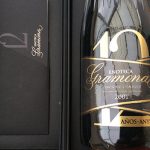CAVA DE PARAJE CALIFICADO – AN UPDATE
It’s something of an on-going saga, I know, but judging by the postbag I receive from avid readers (come on, I’m a journalist, exaggeration is what we do) the subject of the new eponymous Cava designation, above, has not yet become tedious. Indeed, there continues to be considerable interest in DO Cava’s attempt to bring Cava up to the level of the world’s finest sparkling wines, both in reality and also in the perception of the consumer.
For too long, cava has been perceived as a far cheaper alternative to Champagne, albeit lacking anything like the excellence of the great French Fizz, but at these prices – who’s complaining?! Well, regular readers will know that gargantuan steps have been made regarding this promotion, and importantly, re upping the quality too. Those of us who have taken off the blinkers (if we ever had them on) and tasted what are now called Premium Cavas (this is a part of DO Cava’s successful promotional drive) will know that in fact, there has always been excellent Cava, vying with Sparkling Wine from our illustrious neighbour.
I won’t bore you with the details of how the concept of Cava de Paraje Calificado came about, all over again (if you are not aware of the relevant Cork Talk articles written since the summer of 2014, please contact me and I’ll send them to you), but I would like to give you an update as to the current state of play. This with grateful acknowledgment of my colleague Amaya Cervera of ‘Spanish Wine Lover’ @spanish_wl and her excellent in-depth article on the same subject.
Contrary to announcements in this column and, also via myself, on Twitter and Facebook, there were no Cavas with the new designation to be bought before Christmas. I’d received this exciting information in good faith, from DO Cava itself, but on reflection I might have realised that they were being a tad ambitious. Given the huge task which requires an in-depth application from the bodegas requesting such elevation (there have been 12 applicants so far), followed by: soil analysis; climate considerations; an exhaustive; International tasting and judging process (in fact only begun on the 2nd December); and finally a seemingly interminable wait for Government approval, which, of course, wasn’t helped by the first, inconclusive, election and the need for another, it’s not surprsing that there is a delay!
But let’s start by briefly explaining what Cava de Paraje Calificado is all about. This new appellation will be considered the top-tier of the cava pyramid, acknowledging the singularity of those Cavas which are eventually approved. Although the word ‘Paraje’ suggests a ‘small area’, it may be considered something of a misnomer, as in fact, whilst approved vineyards may indeed be small, perhaps just one or two hectares, they can also be very large tracts of land.
The secret is that no matter how large is the area, it must have the same, consistent soil and micro-climate profile. It is also possible for individual, distinct parcels of land within a bodegas total vineyard area, which share the same profiles, that are different from the rest of the vineyard area, to be accepted for the new status. And this goes further – individual areas which differ from themselves, as well as from the larger area can be accepted for individual Cava de Paraje Calificada in their own rights. A bodega may therefore have more than one approved and label acknowledged such higher tier Cava. The clue is in the word ‘singularity’.
There are other important rules too. The minimum age of the vines withing the areas applying is ten years. Actually, this surprised me – I would have thought that they would be looking for older vines, fewer, but better grapes, as you know. I wonder if there has been some bowing to pressure from some of the larger concerns here, or less cynically, this may just have been part of the whole negotiating process, started well before my original visit in 2014.
Next we come to the controversial question of permitted grape varieties, all of which must be picked by hand, and yields will be tightly controlled. Originally, there were those who passionately appealed for the exclusive use of just native varieties, of which Macabeo, Parellada and Xarel.lo are the most widely used. However, after much discussion it was considered that all varieties already permitted for Cava productions should be allowed – so Pinot Noir and Chardonnay are also in!
Finally, for now at least, the minimum time permitted ‘en rima’ (cellared bottles upside down with their lees) is 36 months, 6 months longer than the current minimum for Gran Reserva, before disgorgement. In fact, many of the very best Cavas have even longer, so this was no hardship for those applying, and in fact, it could be argued that it has helped speed up the process, in that there will be many bottles ‘en rima’ now, originally destined to become ‘just’ Gran Reservas, which, should applications be approved, will come out of the bodegas labeled Cava de Paraje Calificado!
Personally, I believe there should be one further requirement – it should be obligatory to display the date of disgorgement on the labels. But, hey we can’t have it all – I guess?
Next Fine Wine & Gourmet Dine Programme on Total FM 91.8 & www.totalfm.es is Sunday 12th February, 18:00 – 20:00 hrs (Spain Time) and we are celebrating our 1st Anniversary! You may guess that we’ll be doing this with Sparkling Wine, of course – but did you know that there are three different methods by which Fizz is made? Well, I’ll be tasting: Cava, made, of course, by the ‘Traditional Method’; Prosecco made by the Charmat Method; and finally, and most unusually Spanish Sparkling Wine made by the Ancestral Method! Why not join me and find out more? Comments/Questions to: colin@colinharknessonwine.com. Plus, during the prog please text (00 34) 629 388 159.



